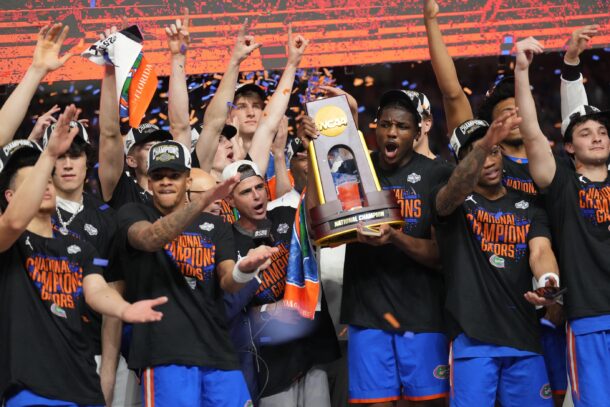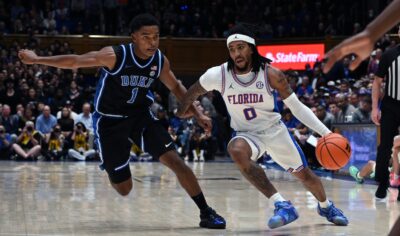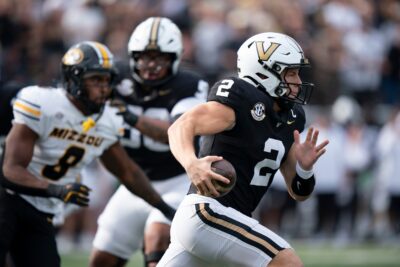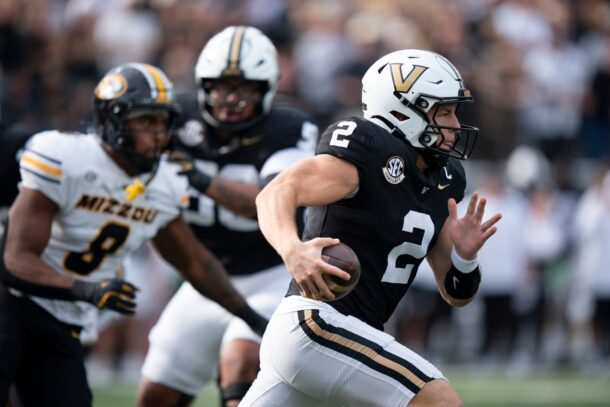
Why Florida basketball had the toughest championship path in at least 25 years
Florida may have just conquered the toughest path to a championship in at least the last 25 years.
There are a few ways that claim can be measured. The first is relatively simple — comparing the sum of Florida’s opponent seeds to previous champions. Using that method, Florida’s path is the toughest since Villanova in 2016. The sum of UF’s opponent seeds in this tournament was 33, which is 1 over the minimum a 1-seed can face en route to a title.
However, that’s a flawed method. The NCAA Tournament selection committee is seeding teams based on their résumé rather than the relative strength of each team. Often those ideas align, but not always. There can be significant inconsistencies, as we saw this year when Gonzaga earned a No. 8 seed despite being rated as a top-10 team by most of the predictive metrics.
To measure based on relative strength, we can use pre-tournament ratings on KenPom that go back to 2001 to judge average opponent strength each champion has faced en route to the title. KenPom standings are based on schedule-adjusted efficiency margin. In layman’s terms: how much better are you than the average Division I team per 100 possessions?
Here’s a chart that shows the average adjusted efficiency margin (AdjEM) for every opponent faced by each March Madness champion dating back to 2001:
As you can see, Florida’s average opponent AdjEM during this NCAA Tournament run is +23.78. In simpler terms, Florida’s NCAA Tournament opponents were collectively almost 24 points per 100 possessions better than the average Division I team during the regular season.
The Gators are in rare air in this category. Since 2001, only 5 champions have faced a run of opponents with an average AdjEM of +20 or better.
Things also got tougher for Florida as the tournament went along. After facing relatively-average strength opponents in Round 1 (Norfolk State, -1.53) and Round 2 (UConn, +19.34), the difficulty ramped up with Maryland in the Sweet 16. The Terps had a pre-tournament rating of +26.35, which is the 2nd-best KenPom rating for that round a champion has had to face since 2001. The only tougher matchup was Utah in 2015 when the Utes met eventual-champion Duke in the Sweet 16.
In the Elite Eight, Florida faced a Texas Tech team with a +28.05 AdjEM. This was the 3rd-toughest Elite Eight draw by this metric since 2001, trailing only matchups faced by 2016 Villanova and those same Blue Devils in 2015.
Things really ratcheted up in the Final Four. Florida was tasked with beating an Auburn team that was +35.05 in the semifinals, which is by far the toughest opponent for any champion at this level of the tournament. The next closest was 2004 UConn, who faced a really good Duke team (+31.73) en route to that title.
Then, of course, there’s Houston. The Cougars came into the tournament with a rating of +35.44. That’s the highest rating of any team to lose in the National Championship Game since 2001 with 1 exception — 2019 Gonzaga, who fell to Baylor despite being a +36.62.
What does this NCAA Tournament say about the future of college basketball … and this record?
There were an unusually-high number of high-rated KenPom teams this year. A whopping 32 teams had adjusted efficiency margins of +20 or better before the start of the NCAA Tournament. That’s not just the most in the last quarter-century, it’s more than double the amount of teams we saw meet that criteria just 2 years ago (14).
There’s no question that parity was at an all-time low (at least in the KenPom era) in college basketball this season. We saw that play out during nonconference action, most notably with the SEC going 59-19 against the other power conferences. We also saw it during the NCAA Tournament when there were precious-few upsets during the first weekend.
Does that mean parity is gone forever in college hoops? I doubt it. The transfer portal (and increased emphasis on NIL) has of course had a huge impact on the sport, but it’s not as if 2025 was the first season with those rules in effect. Again, just 2 years ago, we had only 14 KenPom teams with +20 rating or better and the NCAA Tournament reflected that parity — San Diego State and Florida Atlantic made improbable runs to the Final Four.
If parity were truly gone forever due to the portal and NIL pushing talent to the top of the food chain, I think we’d have seen a more gradual rise in the number of elite teams over the past few years. The reality has been much more sporadic.
Here’s a year-by-year breakdown on the number of KenPom teams with a pre-tournament efficiency margin of +20 or better:
Another huge factor in these year-to-year results is nonconference scheduling at the top of college basketball. This year, the top 10 pre-tournament teams in KenPom had a scoring margin better than +10 per game during nonconference action against the other power conferences. Two years ago that number was closer to +6.
It’s certainly possible the power leagues have “solved” nonconference scheduling to some extent. Some fans will remember the outcry against the Big 12 in 2024 as the league appeared to be much better than it actually was thanks to some savvy scheduling. That talk quieted down in 2025, but maybe it shouldn’t have. The Big 12’s KenPom rating this year (+17.09) was actually a little higher than it was the year before (+16.66), but the league didn’t get nearly as much attention because the SEC (+22.09) and Big Ten (+19) were so far above the Big 12 this season in terms of overall conference strength.
Whether or not this record holds for any significant period of time likely depends on the level of parity in college basketball moving forward. If each league having a small (or in the SEC, rather large) handful of dominant teams becomes a trend, then it’s very possible we’ll see more NCAA Tournaments like this one — and thus perhaps someone will face a tougher path than the Gators endured.
But, there’s another side to that coin. It’s also very possible the SEC over-performed in nonconference play this season — it was 30-4 against the ACC alone! — to an unsustainable degree. If leagues like the SEC and Big Ten regress to the mean in nonconference play in 2025-26 and beyond, it will have a huge impact on AdjEM for top teams and therefore the longevity of this record.
Spenser is a news editor for Saturday Down South and covers college football across all Saturday Football brands.







